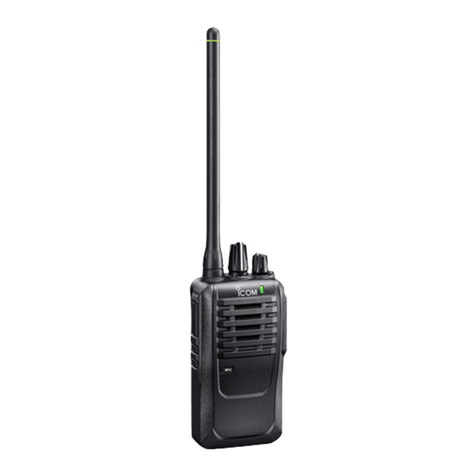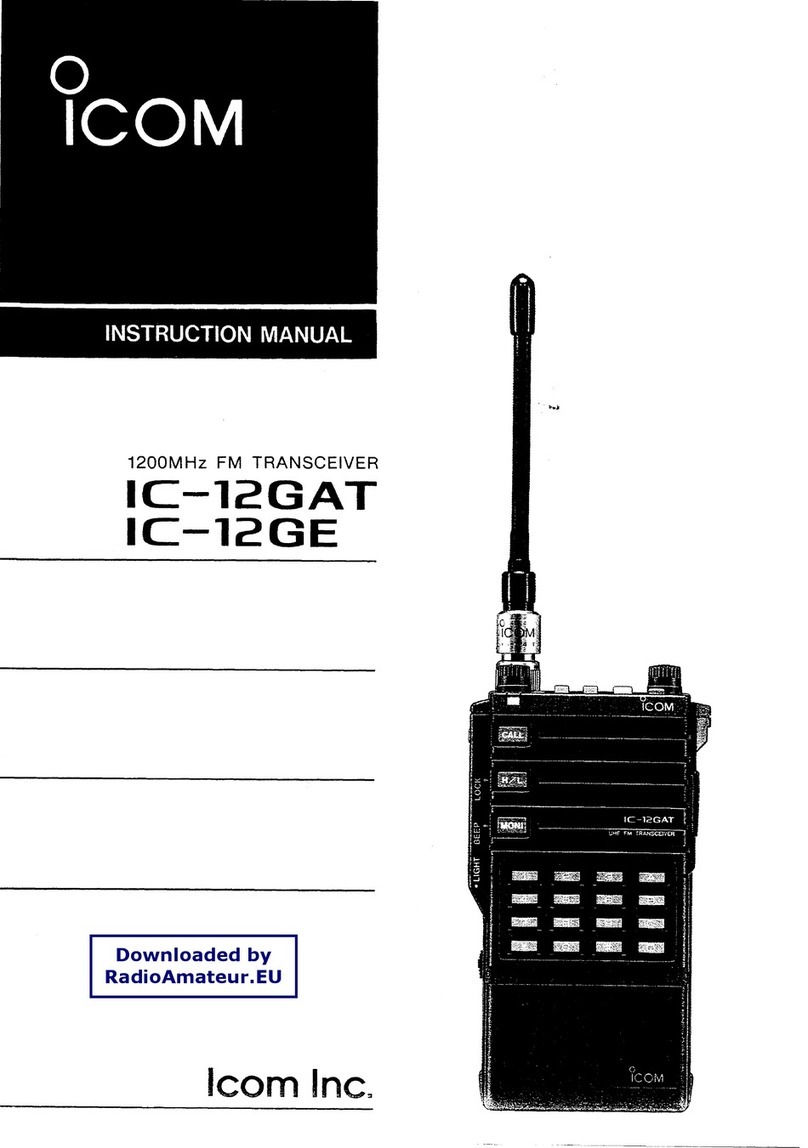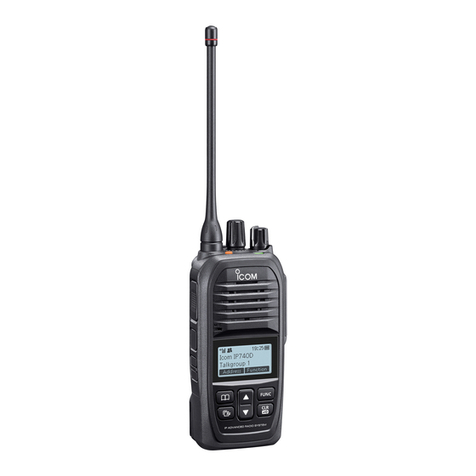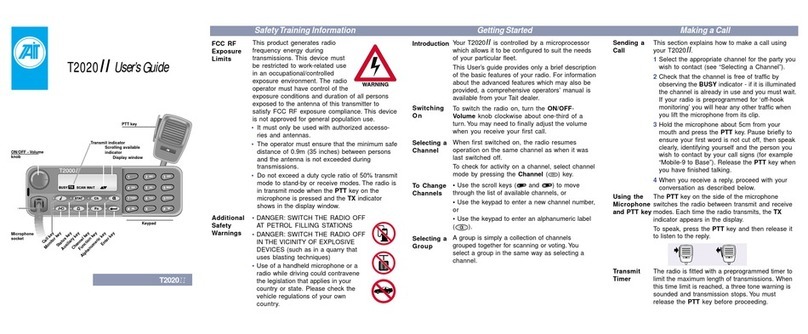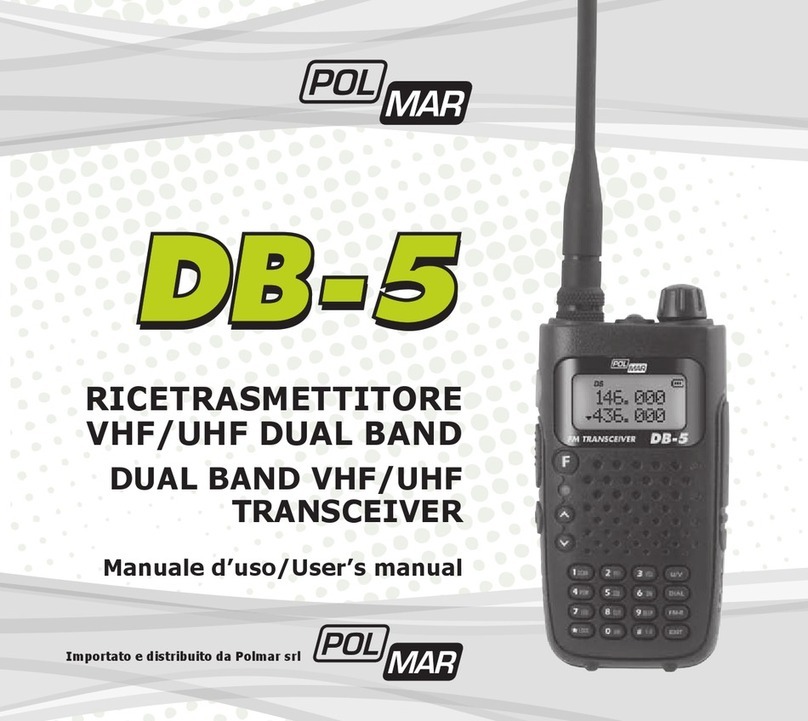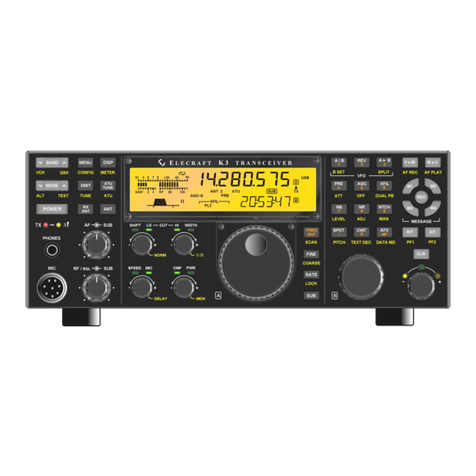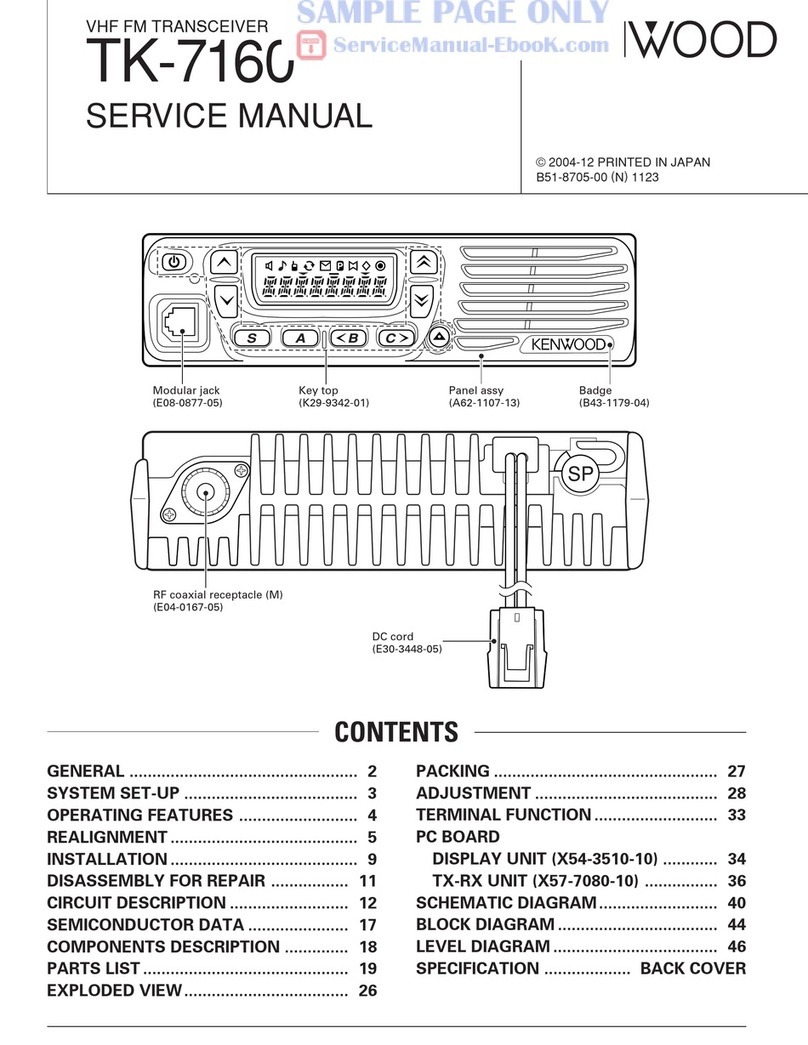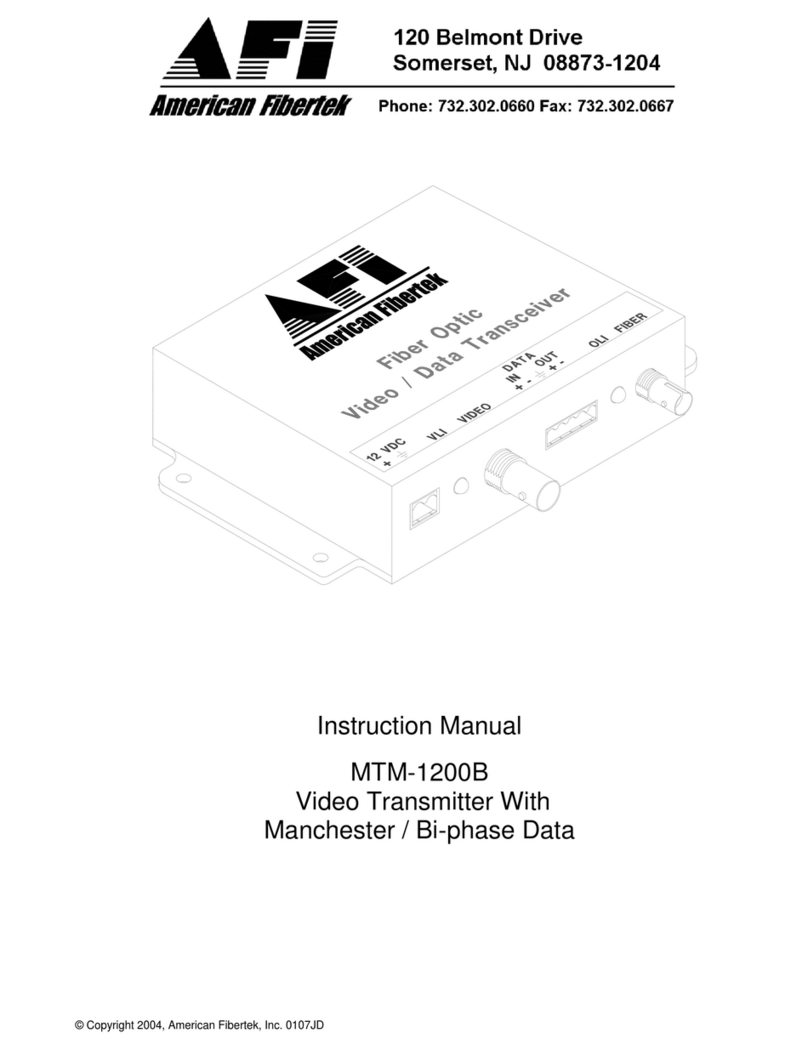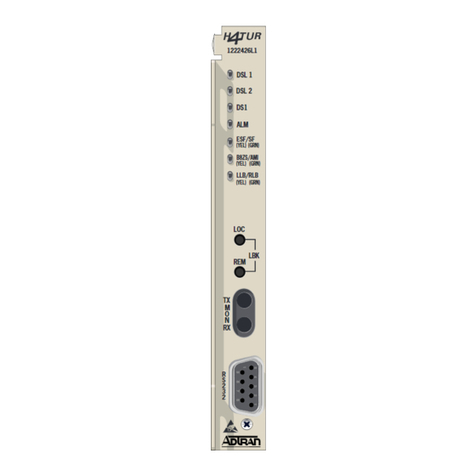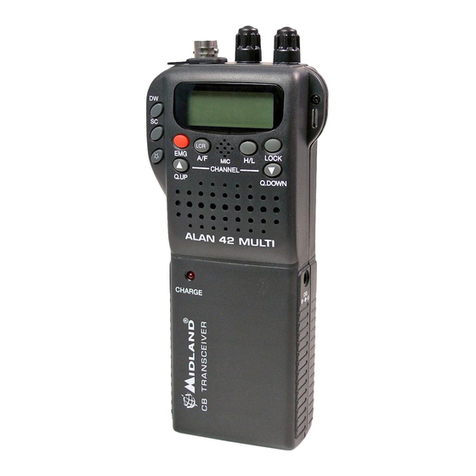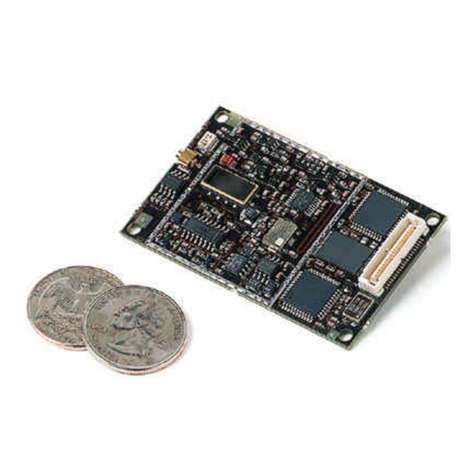Icom IC-A24 User manual

INSTRUCTION MANUAL
iA6
iA24
VHF AIR BAND TRANSCEIVER
This device complies with Part 15 of the FCC
Rules. Operation is subject to the condition
that this device does not cause harmful inter-
ference.
IC-A24 IC-A6

i
SAFETY TRAINING INFORMATION
WARNING
Your Icom radio generates RF electromagnetic energy during
transmit mode. This radio is designed for and classified as
“Occupational Use Only”, meaning it must be used only dur-
ing the course of employment by individuals aware of the
hazards, and the ways to minimize such hazards. This radio
is NOT intended for use by the “General Population” in an
uncontrolled environment.
This radio has been evaluated for compliance at the distance of 2.5 cm with
the FCC RF exposure limits for “Occupational Use Only”. In addition, your
Icom radio complies with the following Standards and Guidelines with regard
to RF energy and electromagnetic energy levels and evaluation of such levels
for exposure to humans:
•FCCOETBulletin65Edition97-01SupplementC,EvaluatingCompli-
ance with FCC Guidelines for Human Exposure to Radio Frequency
Electromagnetic Fields.
•AmericanNationalStandardsInstitute(C95.1-1992),IEEEStandardfor
Safety Levels with Respect to Human Exposure to Radio Frequency
ElectromagneticFields,3kHzto300GHz.
•AmericanNationalStandardsInstitute(C95.3-1992),IEEERecom-
mended Practice for the Measurement of Potentially Hazardous Electro-
magnetic Fields– RF and Microwave.
•Thefollowingaccessoriesareauthorizedforusewiththisproduct.Useof
accessories other than those specified may result in RF exposure levels
exceeding the FCC requirements for wireless RF exposure.; Belt Clip
(MB-86/103),SpeakerMicrophone(HM-173),RechargeableNi-MHBat-
teryPack(BP-210N)andAlkalineBatteryCase(BP-208N).
To ensure that your expose to RF electromagnetic en-
ergy is within the FCC allowable limits for occupational
use, always adhere to the following guidelines:
•DO NOT operate the radio without a proper antenna attached, as this
may damage the radio and may also cause you to exceed FCC RF expo-
sure limits. A proper antenna is the antenna supplied with this radio by
the manufacturer or antenna specifically authorized by the manufacturer
for use with this radio.
•DO NOTtransmitformorethan50%oftotalradiousetime(“50%duty
cycle”).Transmittingmorethan50%ofthetimecancauseFCCRFexpo-
sure compliance requirements to be exceeded. The radio is transmitting
when “ ” appears on the function display. You can cause the radio to
transmit by pressing the “PTT” switch.
•ALWAYS keeptheantennaatleast2.5cm(1inch)awayfromthebody
when transmitting and only use the Icom belt-clips which are listed on
page 32 when attaching the radio to your belt, etc., to ensure FCC RF
exposure compliance requirements are not exceeded. To provide the re-
cipients of your transmission the best sound quality, hold the antenna at
least5cm(2inches)fromyourmouth,andslightlyofftooneside.
The information listed above provides the user with the information needed to
make him or her aware of RF exposure, and what to do to assure that this
radio operates with the FCC RF exposure limits of this radio.
Electromagnetic Interference/Compatibility
During transmissions, your Icom radio generates RF energy that can possibly
cause interference with other devices or systems. To avoid such interference,
turn off the radio in areas where signs are posted to do so. DO NOT operate
the transmitter in areas that are sensitive to electromagnetic radiation such as
hospitals and blasting sites.
Occupational/Controlled Use
The radio transmitter is used in situations in which persons are exposed as
consequence of their employment provided those persons are fully aware of
the potential for exposure and can exercise control over their exposure.
CAUTION

ii
FOREWORD
ThankyouforpurchasingthisIcomproduct.TheIC-A24/A6
VHF AIR BAND TRANSCEIVER is designed and built with
Icom’s state of the art technology and craftsmanship. With
proper care this product should provide you with years of
trouble-free operation.
IMPORTANT
READ ALL INSTRUCTIONS carefully and completely
before using the transceiver.
SAVE THIS INSTRUCTION MANUAL—This in-
struction manual contains important operating instructions
fortheIC-A24/A6.
EXPLICIT DEFINITIONS
SUPPLIED ACCESSORIES
Accessories included with the transceiver: Qty.
q Antenna .......................................................................... 1
w Belt clip .......................................................................... 1
e Handstrap ...................................................................... 1
r Battery pack* or battery case.......................................... 1
t Wall charger* .................................................................. 1
yCarrying case* ............................................................... 1
uHeadset adapter* ........................................................... 1
* Not supplied, or the shape may be different, depending on the
version.
WORD DEFINITION
RWARNING!
CAUTION
NOTE
Personal injury, fire hazard or electric shock
may occur.
RDANGER! Personal death, serious injury or an explo-
sion may occur.
If disregarded, inconvenience only. No risk
of personal injury, fire or electric shock.
Equipment damage may occur.
qw e
t
r
y
u

iii
R DANGER! NEVER short the terminals of the battery
pack. Also, current may flow into nearby metal objects, such
as a necklace, etc. Therefore, be careful when carrying with,
or placing near metal objects, carrying in handbags, etc.
R DANGER! Use and charge only specified Icom bat-
tery packs with Icom radios or Icom chargers. Only Icom
battery packs are tested and approved for use with Icom ra-
dios or charged with Icom chargers. Using third-party or
counterfeit battery packs or chargers may cause smoke, fire,
or cause the battery to burst.
R WARNING! NEVER hold the transceiver so that the
antenna is very close to, or touching exposed parts of the
body, especially the face or eyes, while transmitting. The
transceiverwillperformbestifthemicrophoneis5to10cm
(
231⁄32 to 315⁄16 inch
)awayfromthelipsandthetransceiveris
vertical.
R WARNING! NEVER operate the transceiver with a
headset or other audio accessories at high volume levels.
Hearing experts advise against continuous high volume op-
eration. If you experience a ringing in your ears, reduce the
volume level or discontinue use.
CAUTION: NEVER connect the transceiver to an AC
outlet or to a power source of more than 11.5 V DC. Such a
connection will damage the transceiver.
CAUTION: NEVER connect the transceiver to a power
source that is DC fused at more than 5 A. Accidental reverse
connection will be protected by this fuse, higher fuse values
will not give any protection against such accidents and the
transceiver will be ruined.
DO NOT allow children to play with any radio equipment
containing a transmitter.
DO NOT operate the transceiver near unshielded electri-
cal blasting caps or in an explosive atmosphere.
DO NOT use or place the transceiver in direct sunlight or
inareaswithtemperaturesbelow–10°C(+14°F)orabove
+60°C(+140°F).
Even when the transceiver power is OFF, a slight current still
flows in the circuits. Remove the battery pack or case from
the transceiver when not using it for a long time. Otherwise,
the battery pack or installed dry cell batteries will become
exhausted.
Icom, Icom Inc. and the Icom logo are registered trademarks of Icom Incorpo-
rated(Japan)inJapan,theUnitedStates,theUnitedKingdom,Germany,
France,Spain,Russiaand/orothercountries.
FCC caution: Changes or modifications to this transceiver,
not expressly approved by Icom Inc., could void your authority
to operate this transceiver under FCC regulations. (U.S.A.
only)
PRECAUTION

iv
SAFETY TRAINING INFORMATION ............................................... i
FOREWORD .................................................................................. ii
IMPORTANT ................................................................................... ii
EXPLICIT DEFINITIONS ................................................................ ii
SUPPLIED ACCESSORIES ........................................................... ii
PRECAUTIONS.............................................................................. iii
TABLE OF CONTENTS ................................................................. iv
1 PANEL DESCRIPTION ...................................................... 1 – 6
■Panel description ................................................................... 1
■Function display .................................................................... 5
2 ACCESSORY ATTACHMENT .................................................. 7
3 BASIC OPERATION ......................................................... 8 – 11
■Setting a frequency ...............................................................8
■Setting a squelch level ..........................................................8
■Selecting a weather channel..................................................8
■Receiving ..............................................................................9
■ANL function .........................................................................9
■Transmitting ...........................................................................9
■Time-Out-Timerfunction(Australiaversiononly) ..................9
■Low battery indicator ...........................................................10
■Recall function ....................................................................10
■Setting weather alert function .............................................. 11
■Accessing the 121.5 MHz emergency frequency ................ 11
■Lock function ....................................................................... 11
■Side tone function ............................................................... 11
■Setting beep tone ................................................................ 11
4 MEMORY OPERATION .................................................. 12 – 15
■Memory channel selection .................................................. 12
■Transferring memory contents ............................................. 12
■Programming a memory channel ........................................ 13
■Memory names ................................................................... 14
■Clearing the memory contents ............................................ 14
5 SCAN OPERATION ........................................................ 16 – 17
■Scan types .......................................................................... 16
■COM band scan .................................................................. 16
■Memory scan ...................................................................... 16
■Weather channel scan (U.S.A.versiononly) ............................17
■“TAG” channels ...................................................................17
6 VOR NAVIGATION (IC-A24 only) ................................... 18 – 24
■VOR indications ...................................................................18
■VOR functions ..................................................................... 19
■Flying to a VOR station .......................................................20
■Entering a desired course ................................................... 22
■Crosschecking position ....................................................... 22
■Duplex operation (U.S.A.versiononly) .................................... 24
7 BATTERY PACKS .......................................................... 25 – 28
■Battery charging .................................................................. 25
■Battery cautions .................................................................. 25
■Optional battery case .......................................................... 26
■Optional battery chargers ....................................................27
8 CLONING ............................................................................... 29
9 TROUBLESHOOTING ........................................................... 30
10 SPECIFICATIONS .................................................................. 31
11 OPTIONS ................................................................................ 32
12 OPTIONAL HEADSET CONNECTION .................................. 33
TABLE OF CONTENTS

1
1PANEL DESCRIPTION
■Panel description
ert
u
y
i
o
Microphone
Speaker
!6
!5
!7
q
w
!1
!0
!2
!3
!4
WX-ALERT
IC-A24
!7
WX-ALERT
!7
IC-A6

2
1
qBACKLIGHT SWITCH [LIGHT]
Turns the backlight for display and keypad ON or OFF.
wPTT SWITCH [PTT](p.9)
Hold down to transmit; release to receive.
•“ ” appears on the function display while transmitting.
eVOLUME [VOL] (p.9)
Adjusts the audio level.
rTUNING DIAL [DIAL] (pp.8–12)
➥Rotate [DIAL] to select the desired frequency, WX
channelnumber,BANKnumberandmemorychannel.
➥Rotate [DIAL] to set the squelch level and beep tone
level.
tANTENNA CONNECTOR [ANT] (p.7)
Connect the supplied antenna here.
yRECALL CHANNEL UP/DOWN KEYS [Ω]/[≈] (p.10)
➥Push to enter the recall function mode.
➥Push to call the stored frequency in the recall
mode.
➥Push , then push [Ω]/[≈] to replace stored
recall frequencies to back or front.
uSQUELCH KEY [SQL•WX-ALERT] (p.8)
➥Push[SQL•WX-ALERT], then rotate [DIAL] to
select the squelch level.
•24squelchlevelsandsquelchopen(0)areavailable.
➥Push ,thenpush[SQL•WX-ALERT] to turn
the WX-alert function ON or OFF.
iPOWER SWITCH [PWR] (pp.9,29)
➥Hold down for 2 sec. to turn the power ON or
OFF.
➥Whileholdingdown[MR•MW], push [PWR] to
enter the cloning function mode.
oEXTERNAL SPEAKER AND MICROPHONE JACKS
[MIC/SP] (p.33)
Ifdesired,connectanOPC-499HEADSET ADAPTER and
headset.
!0 FUNCTION KEY [ ]
Push to call up the function indicator, “ ”, then
push another key to access its secondary func-
tion.
•“ ” appears for 3 sec. after is pushed; at this time
pushing again cancels the indication.
NOTE: In general, “ ” disappears when an-
other key is pushed to activate a secondary
function. However, some keys which have
morethanonesecondaryfunction,(suchas
[DUP]),donotcancel“ ”. In this case, “ ”
automatically disappears after 3 sec.
1
PANEL DESCRIPTION

3
1PANEL DESCRIPTION
!1 CLEAR KEY [CLR•DEL] (pp.8–17)
➥Push to return to the frequency mode, when
memory channel, WX channel, 121.5 MHz,
squelch level setting or beep tone setting is se-
lected.
➥Push ,thenholddown[CLR•DEL]to delete
a recall frequency data.
➥Push to clear the entered comment of memory
name while programming.
➥Push to stop the scan function to return to the
frequency mode while the scan function is op-
erating.
!2 ANL KEY [ANL•SCAN] (pp.9,16,17)
➥Push to turn the ANL function ON or OFF.
➥Push ,thenpush[ANL•SCAN]to start the
scan function.
!3 EMERGENCY KEY [121.5 MHz] (p.11)
Push for 2 sec. to select the 121.5 MHz emer-
gency frequency.
!4 DC POWER JACK
Connect the AC adapter or optional cable, to charge the
batterypackortooperatebyexternalpower.(seerightil-
lustration)
!5 MEMORY MODE KEY [MR•MW] (pp.12–15)
➥Push to select the memory channel mode.
➥Push ,thenpush[MR•MW]to program the
contents into the memory channels.
!6 ENTER KEY [ENT•WX] (pp.8,14)
➥Push to store the numeral input. Enters con-
secutivezerodigits.(p.8)
➥Push ,thenpush[ENT•WX]to enter the
weatherchannelselectionmode(U.S.A.ver-
siononly).(p.8)
➥Pushtoprogramthememoryname.(p.14)
NOTE: Some functions may not be available depending on
versions. Ask your authorized dealer for details.
Wall charger
To [DC 11V]
IC-A24/A6
CP-20 (for 11 24 V)
(optional)
To the cigarette
lighter socket
To AC outlet
The shape may
differ depending
on the version.
• DC POWER CONNECTION
R WARNING!
•NEVER modify the CP-20.Amodification
could cause a fire or electrocution.
•NEVERcutorfraytheCP-20’spowercable
whendisconnecting/connectingtheCP-20
from/tothecigarettelightersocket.

4
1
PANEL DESCRIPTION
1
!7 DIGIT KEYS
➥Input the specified digit during frequency input, mem-
ory channel selection, etc.
➥In addition, each key has one or more secondary func-
tions after pushing as follows:
Push ,thenpush[0•BANK], and rotate [DIAL]
toselectthememoryBANKnumberduringmem-
ory mode operation. (p.12)
Push ,thenpush[1•DVOR] to select the DVOR
display from the CDI display in the NAV band. (p.
19)*1
➥Push ,thenpush[2•TO] to change the
course indicator characteristics to a “TO” flag in
the DVOR display in the NAV band. (p.19)*1
➥Corrects the deviation while using the “TO”
flag.*1
➥Push ,thenpush[3•FROM] to change the
course indicator characteristics to a “FROM”
flag in the DVOR display in the NAV band. (p.
19)*1
➥Corrects the deviation while using the “FROM”
flag.*1
Push ,thenpush[4•CDI] to select the CDI dis-
play from the CDI display in the NAV band. (p.
19)*1
Push ,thenpush[5•DUP-W] to set the duplex
frequency in the NAV band for U.S.A. version only.
(p.24)*1
Push ,thenpush[6•DUP] to turn the duplex
function ON and OFF in the NAV band for U.S.A.
version only. (p.24)*1
Push ,thenpush[7• ] to turn the key lock
function ON and OFF. (p.11)
Push ,thenpush[8•BEEP] to turn the beep
tonesettingmodeON.(p.11)
•Adjustablelevel;0to9
Push ,thenpush[9•TA G ] to set the displayed
memory or weather channel as a “TAG” channel.
(p.17)
*1 These functions are available on the IC-A24 only.

5
1PANEL DESCRIPTION
■Function display
qFUNCTION INDICATOR (p.2)
Appears when is pushed.
wTX INDICATOR(p.9)
Appears while transmitting.
eRX INDICATOR(p.9)
Appears when receiving a signal, or when the squelch
opens.
rDUPLEX INDICATOR(IC-A24only) (p.24)
➥“DUP” appears when the duplex function is activated in
the NAV mode.
➥“DUP” blinks while setting the duplex frequency.
tLOW BATTERY INDICATOR (p.10)
➥Appears when the battery is nearing exhaustion. The
attached battery pack requires recharging.
➥Appears and flashes when battery replacement is nec-
essary.
yLOCK INDICATOR (p.11)
Appears while the lock function is in use.
uFREQUENCY DISPLAY (pp.8,14)
➥Shows the operating frequency.
➥Shows the channel name when the memory name
function is selected.
i
qw erty
o
!0
!1!1 !2!3
!4
u
!5

6
1
PANEL DESCRIPTION
1
iTAG CHANNEL INDICATOR(p.17)
“ ” appears when the selected memory channel is set
as a TAG channel.
oMEMORY CHANNEL INDICATOR (pp.12–15)
Shows the selected memory channel number.
!0 MEMORY BANK NUMBER INDICATOR(p.12)
Shows the selected memory bank number.
!1 OVERFLOW INDICATOR (IC-A24only) (pp.18–22)
Appears when the deviation between the desired course
andyingcourseisover10degrees.
!2 ANL INDICATOR(p.9)
AppearswhiletheANL(AutomaticNoiseLimiter)function
is in use.
!3 COURSE DEVIATION NEEDLES (IC-A24only)
(pp.18–22)
Indicates every 2 degree deviation between the desired
course and your actual flying course every 2 degrees.
!4 COURSE INDICATORS (IC-A24only) (p.19)
➥Indicates where your aircraft is located on a VOR radial
in the DVOR mode.
➥Indicates where your desired course is located on a
VOR radial in the CDI mode.
!5 TO-FROM INDICATOR (IC-A24only) (p.19)
Indicates whether the VOR navigation information is
based on a course leading to the VOR station or leading
away from the VOR station.

7
DAntenna
CAUTION: DO NOT transmit without an antenna. Other-
wise the transceiver may be damaged.
Insert the supplied antenna into the antenna connector and
screw down the antenna as shown below.
DBelt clip
Conveniently attaches to your belt.
Attach the belt clip with the supplied screws as below.
NOTE: Use the supplied screws only.
DBattery pack replacement
Before replacing the battery pack, push [PWR] for 2 sec. to
turn the power OFF.
Slide the battery release button forward, then pull the battery
pack upward with the transceiver facing away from you.
Supplied screws
2ACCESSORY ATTACHMENT
NOTE: About water resistant construction
The water resistant construction provides reliable opera-
tion in wet conditions.
•EquivalenttoIPX4ofcorrespondinginternationalstand-
ardIEC60529(2001).

8
3
BASIC OPERATION
■Setting a frequency
ï Using keypad
qPush [PWR] for 2 sec. to turn power ON, then push
[CLR•DEL] to select the frequency mode when memory
CH number or WX CH number appears on the function
display.
wPush 5 appropriate digit keys to input the frequency.
•Push[1•DVOR] as the 1st digit.
•Whenawrongdigitisinput,push[CLR•DEL] to clear,
then repeat step wagain.
•Push[ENT•WX] to enter consecutive zero digits.
•Only[2•TO],[5•DUP-W],[7• ]and[0•BANK] can be en-
tered as the 5th and final digit.
[EXAMPLE]
•111.225MHz:Push
•117.250MHz:Push
•120.000MHz:Push
•125.300MHz:Push
ï Using the tuning dial
qPush [PWR] for 2 sec. to turn power ON, then push
[CLR•DEL] to select the frequency mode when memory
CH number or WX CH number appears on the function
display.
wRotate [DIAL] to set the desired frequency.
•Toselectthe1MHztuningstep,push , then rotate
[DIAL]. Push again to return to the normal tuning.
■Setting a squelch level
The transceiver has a noise squelch circuit to mute unde-
sired noise while receiving no signal.
qPush[SQL•WX-ALERT], then rotate [DIAL] to select the
squelch level.
•‘SQL--0’isopensquelchand‘SQL--24’istightsquelch.
•“ ” appears while the squelch is open.
w Push[SQL•WX-ALERT]or[CLR•DEL] to exit the squelch
set mode.
■Selecting a weather channel
(U.S.A. version only)
TheU.S.A.versionhasVHFmarineWX(weather)channel
receiving capability for flight planning.
q Push ,thenpush[ENT•WX] to select WX channel
mode.
•“WX--”andthepreviouslyselected
channel number appears.
w Rotate [DIAL] to select the de-
sired WX channel.
e Push[CLR•DEL] to exit the WX
channel mode and return to fre-
quency mode.
2
3

9
3BASIC OPERATION
■Receiving
q Push [PWR] for 2 sec. to turn the power ON.
wPush[SQL•WX-ALERT], then rotate [DIAL] counterclock-
wisetoselectthesquelchlevel0.
e Rotate [VOL] to adjust the audio level.
r Push[SQL•WX-ALERT], then rotate [DIAL] clockwise until
the noise is muted.
•“ ” indicator disappears.
t Set the desired frequency using [DIAL] or keypad.
y When a signal is received on the set frequency:
•“ ” indicator appears.
•Squelchopensandaudioisemittedfromthespeaker.
When [SQL] setting is too “tight,” squelch may not open for
weak signals. To receive weaker signals, loosen the squelch.
■ANL function
Whilereceiving,theANL(AutomaticNoiseLimiter)function
reduces noise components such as those that are caused
by engine ignition systems while receiving.
•Push[ANL•SCAN]toturntheANLfunctionON/OFF.
“ ” appears on the display while the ANL function is ON.
■Transmitting
q Set the desired frequency in COM band using [DIAL] or
keypad.
•COMbandfrequencyrange:118.00–136.975MHz
w Hold down [PTT] to transmit.
•“ ” indicator appears.
e Speak into the microphone at a normal voice level.
•DO NOT hold the transceiver too close to your mouth or speak
too loudly. This may distort the signal.
r Release [PTT] to return to receive.
■Time-Out-Timer function
(Australia version only)
To prevent prolonged transmission, and according to regula-
toryrequirements,theIC-A6(Australiaversiononly)hasa
Time-Out-Timer function. This timer cuts a transmission OFF
after 3 minutes of continuous transmission.
CAUTION: Transmitting without an antenna may damage
the transceiver.
NOTE: To prevent interference, listen on the frequency
before transmitting. If the frequency is busy, wait until the
channel is clear.

10
3
BASIC OPERATION
■Low battery indicator
Low battery indicator appears
when the battery power has de-
creased to a specified level. The
attached battery pack requires
recharging.
■Recall function
Therecallfunctionstoresthelast10frequenciesused.
The function stores frequencies when the frequency is pro-
grammedandtransmittedon(exceptmemory,weatherand
emergencychannels).
DRecalling the stored frequencies
➥Push to recall the 1st stored frequency.
➥Push torecallthe10thstoredfrequency.
DDeletes the stored recall channel
qPush or to select the channel to be deleted.
wPush ,thenpush[CLR•DEL] for 2 sec. to delete it.
•(e.g.)Whenthe“r0”recallchannelwhichisstored120.450MHz
isdeleted,the“r1”recallchannelwhichisstored123.450MHz
moveupto“r0”.
DReplaces the stored recall channel
qPush or to select the recall channel to be re-
placed.
wPush , then push or to replace it.
•Replacestheselectedchannelintothepreviouschannelwhen
is pushed and then is pushed.
•Replacestheselectedchannelintothenextchannelwhen
is pushed and then is pushed.
•(e.g.)Toreplace“r0”whichisstoredas121.375MHzinto“r1”,
push , then push .
NOTE: When the number of stored frequencies reaches
10,channelsareautomaticallydeletedasneeded,inthe
order they were entered, beginning the oldest.
Low battery indicator
Recall number appears.
: Push
: Push
•Recallnumberrotation
3

11
3BASIC OPERATION
■Setting weather alert function
An NOAA broadcast station transmits a weather alert tone
before any important weather announcements. When the
weather alert function is turned ON, the transceiver detects
the alert, and sounds a beep tone until the transceiver is op-
erated.Thepreviouslyselected(used)weatherchannelis
checked any time during standby, or while scanning.
•
Push ,thenpush[SQL•WX-ALERT] to turn ON the
weatheralertfunction(displays“ ”for1second)/
OFF(displays“ ”for1second).
■Accessing the 121.5 MHz
emergency frequency
The IC-A24 and IC-A6 can set to the 121.5 MHz emergency
frequency quickly. This function can be activated even when
the key lock function is in use.
qPush [121.5] for 2 sec. to select the emergency frequency.
wPush[CLR•DEL] to exit the emergency frequency.
■Lock function
The lock function prevents accidental frequency changes
and accidental function activation.
qPush ,thenpush[7• ] to turn the lock function ON.
•“ ” appears.
wTo turn the function OFF, repeat step qabove.
•“ ” disappears.
■Side tone function
Whenusinganheadset(othermanufacture’sproducts), the
transceiver outputs your transmitted voice to the headset for
monitoring. Connect the optional headset with the trans-
ceiverwhenusingthisfunction(OPC-499HEADSET
ADAPTER and headset are required)(p.33).
DSetting the side tone level
qPush [PTT] to turn the transmit mode ON.
wDuring transmit mode, rotate [DIAL] to adjust the monitor-
ing level.
•‘ST--0’isOFFand‘ST--10’ismaximumlevel.
RWARNING! NEVER operate the transceiver with a
headset at high volume levels for long period. A ringing in
your ears may occur. If so, reduce the monitor level or
discontinue use.
■Setting beep tone
If desired, the beep tone, which sounds at the push of a
switch, can be set.
q Push , thenpush[8•BEEP] to enter the beep tone
setting mode.
w Rotate [DIAL] to set the beep level.
•‘BEP--0’isOFFand‘BEP--9’ismaximumlevel.
•2beepssoundtonetoverifysetbeeptonelevel.
e Push[CLR•DEL] to exit the beep tone setting mode.
IMPORTANT:Setthemonitoringlevelto‘ST--0’whenusing
anoptionalHM-173SPEAKER MICROPHONE, otherwise,
your voice will be heard from the speaker during transmitting.

12
4
MEMORY OPERATION
■Memory channel selection
Thetransceiverhas200memorychannelsforstorageof
often-used frequencies, along with 6-character notes.
q Push[MR•MW] to select the memory mode.
•ThememoryBANKnumberandmemoryCHnumberappears.
Using [DIAL]:
w Push ,thenpush[0•BANK], and rotate [DIAL] to select
thedesiredmemoryBANKnumber.Push and push
[0•BANK](orpush[CLR•DEL])toexittheBANKselection
mode.
e Rotate [DIAL] to select the desired memory CH number.
•IfnomemoryCHisprogrammedintheselectedBANK,no
memory CH selection is available.
Using the Keypad:
w Push ,andpush[0•BANK], then push the appropriate
digitkey([0•BANK]to[9•TA G ])toselectthedesiredmem-
oryBANKnumber,thenpush andpush[0•BANK](or
push[CLR•DEL])toexittheBANK-selectionmode.
e Push2appropriatedigitkey(00to19)toselectthede-
sired memory CH number.
•IfnomemoryCHisprogrammedintheselectedBANK,no
memory CH selection is available.
NOTE: Comments appear first when programmed, how-
ever, the transceiver can be programmed by your dealer
toshowtheoperatingfrequencyfirst.Push[MR•MW] to
display the comment in this case.
■Transferring memory
contents
This function transfers a memory channel’s contents into the
frequency mode. This is useful when searching for signals
around a memory channel’s frequency.
qPush[MR•MW] to select memory mode.
wSelect the desired memory channel to be transferred
using [DIAL] or keypad.
ePush ,thenpush[MR•MW] to transfer the memory
channel’s contents into the frequency mode.
•BANKnumberandmemoryCHnumberdisappearsasfre-
quency mode is automatically selected and the memory con-
tents are transferred.
Memory mode Frequency mode
3
4

13
4MEMORY OPERATION
■Programming a memory
channel
Thetransceiverhas200(20CH×10BANK)memorychan-
nels for storage of often-used frequencies.
q Push[CLR•DEL] to select the frequency mode, if neces-
sary.
w Select the desired frequency.
•Push , thenpush[ENT•WX] to select a weather channel.*
•Setthedesiredfrequencyorweatherchannel*using[DIAL]or
keypad.
ePush , thenpush[MR•MW] to enter the memory writ-
ing mode.
•“M”,MemoryBANKandmemorychannelnumberareblink.
rRotate [DIAL] to select the desired memory channel
number.
•Push ,thenpush[0•BANK], and rotate [DIAL] to select the
BANKnumberifdesired.
•Push[CLR•DEL],[ENT•WX] or push thenpush[0•BANK] to
exittheBANKselectionmode.
tPush[ENT•WX] to program the information into the chan-
nel and return to the frequency mode.
*Weather channel: U.S.A. version only.
(orrotate[DIAL])
(orrotate[DIAL])
Push
Push
Push
Push
Push
or
or
Push
Push
Push
or
• EXAMPLE:ProgrammingWX-05*intomemoryBANK3/
memorychannel9.

14
4
MEMORY OPERATION
■Memory names
ï Programming memory names
The memory channel can display a 6-character name in-
stead of the programmed frequency.
q In the frequency mode, rotate [DIAL] to select the desired
frequency in the frequency mode.
w Push ,thenpush[MR•MW] to program the contents
into the selected memory channel.
e Rotate [DIAL] to select the desired memory channel to be
programmed.
•Push ,thenpush[0•BANK], and rotate [DIAL] to select the
BANKnumber,ifdesired.Push[CLR•DEL]toexittheBANKse-
lection mode.
r Push[MR•MW] to enter the memory name programming
mode.
•“------------”appearsonthedisplay.
t Push the appropriate digit key several times to select the
desired character, as listed to the right.
•Toeraseacharacter,overwritewithaspace(displayedas_).
•Tomovethecursorforwardsorbackwards,use[DIAL].
y Push[ENT•WX] to program the name.
•Thememorynamestopsashing.
•Whennonameisprogrammed,thedisplayshowstheoperat-
ing frequency.
•Tocleartheenteredmemorynames,push[CLR•DEL] before
pushing[ENT•WX].
NOTE: When programming the memory name to the pro-
grammed memory channel do the following.
qFollow the same steps as in “Transferring memory con-
tents”(seep.12).
wFollow steps w–yin “Programming memory names”
(seeleftcolumn).
■
Clearing the memory contents
Unwanted memory channels can be cleared.
qSelect the memory channel to be cleared.
wPush , thenholddown[CLR•DEL] for 1 sec.
•“------------”appearsmomentarily,thenthenextselectable
channel appears.
Key Character Key Character Key Character
1 1, Q, Z 2 2, A, B, C 3 3, D, E, F
4 4,G,H,I 5 5,J,K,L 6 6,M,N,O
7 7,P,R,S 8 8,T,U,V 9 9,W,X,Y
ENT Program 0 0,space,-
4

15
4MEMORY OPERATION
Push
Push
Push
Push
Push
Push
Push
Push Push
Push
Push
(orrotate[DIAL])
(orrotate[DIAL])
• EXAMPLE:Programming125.000MHzintomemoryBANK1/memorychannel17with“AIR-23”asacomment.
NOTE: Push ,thenpush[0•BANK], and then rotate
[DIAL]toselecttheBANKnumber,ifdesired.Push
[CLR•DEL]toexittheBANKselectionmode.
Other manuals for IC-A24
7
This manual suits for next models
1
Table of contents
Other Icom Transceiver manuals
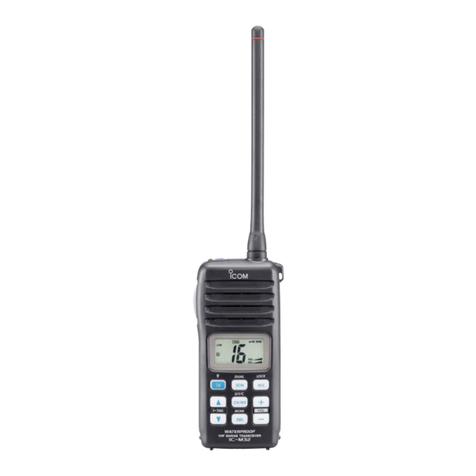
Icom
Icom IC-M32 User manual
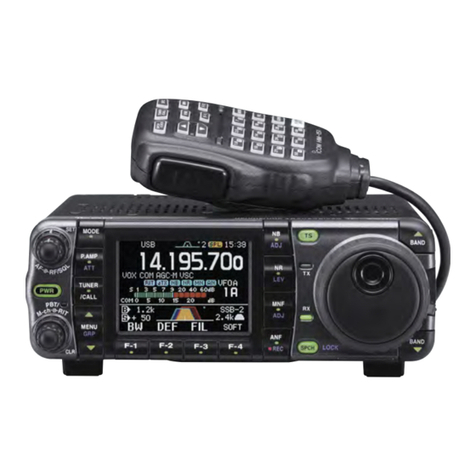
Icom
Icom IC-7000 User manual
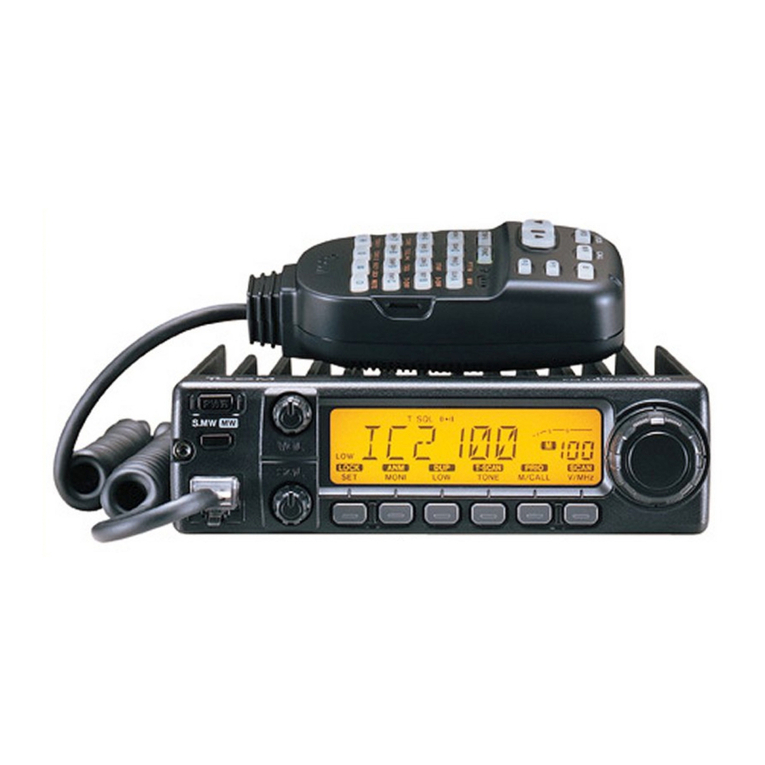
Icom
Icom IC-2100H User manual
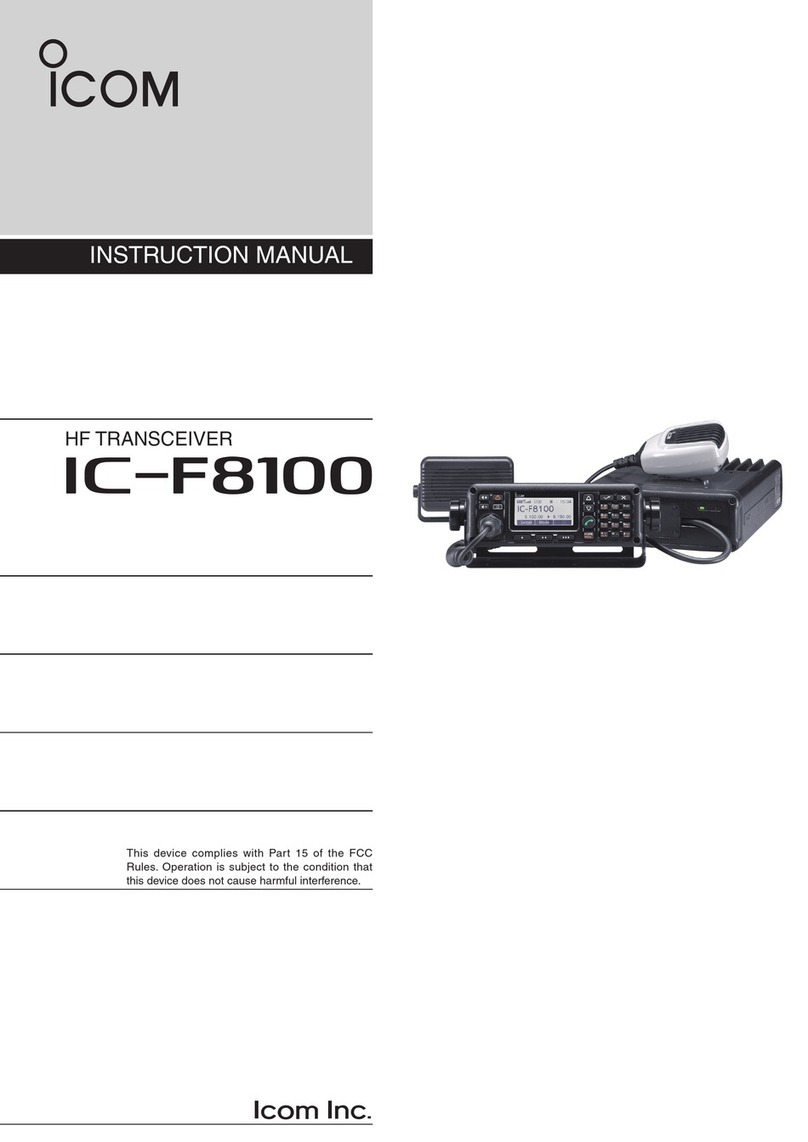
Icom
Icom IC-F8100 User manual

Icom
Icom IC-M87 User manual

Icom
Icom IC-7000 User manual
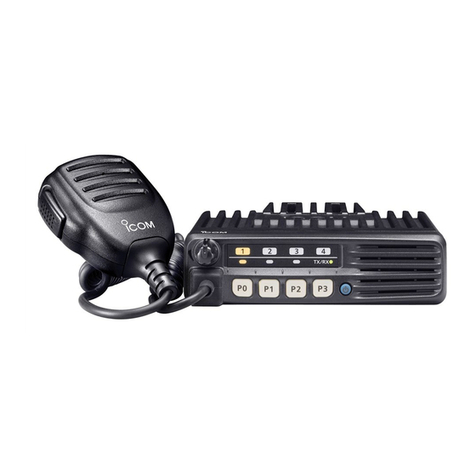
Icom
Icom IC-F6012 User manual
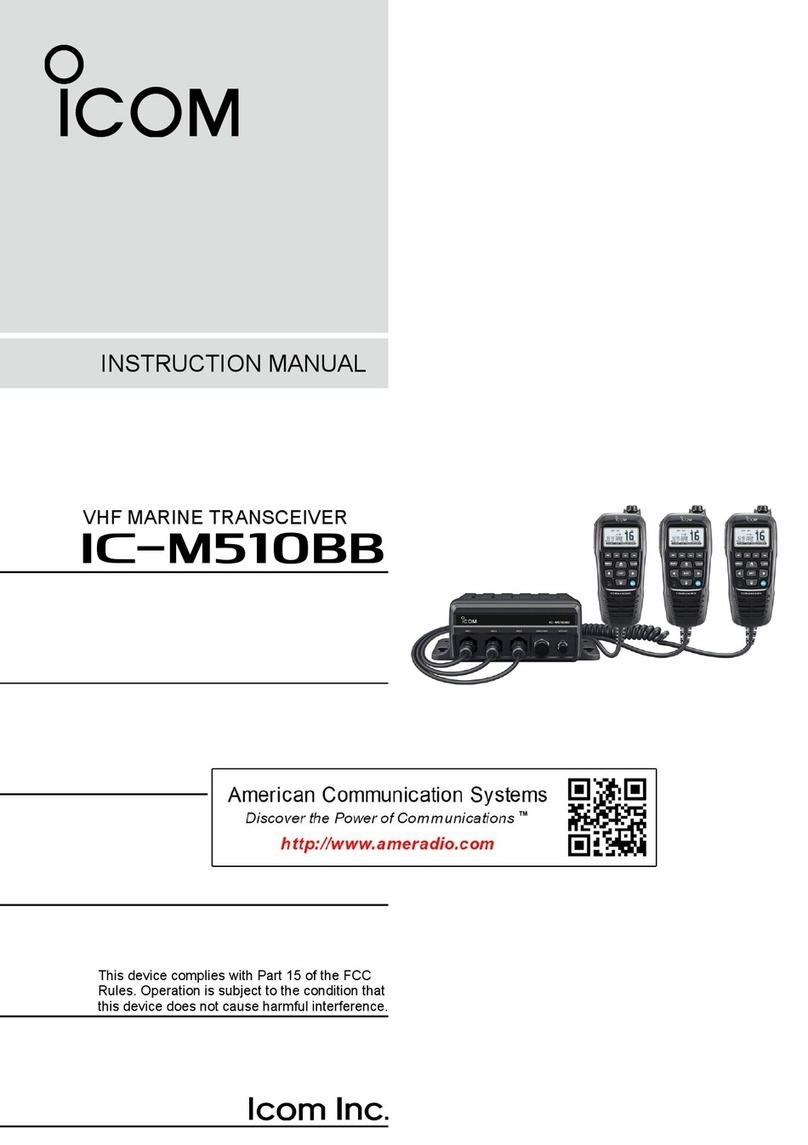
Icom
Icom IC-M510BB User manual

Icom
Icom IC-F3162D series User manual
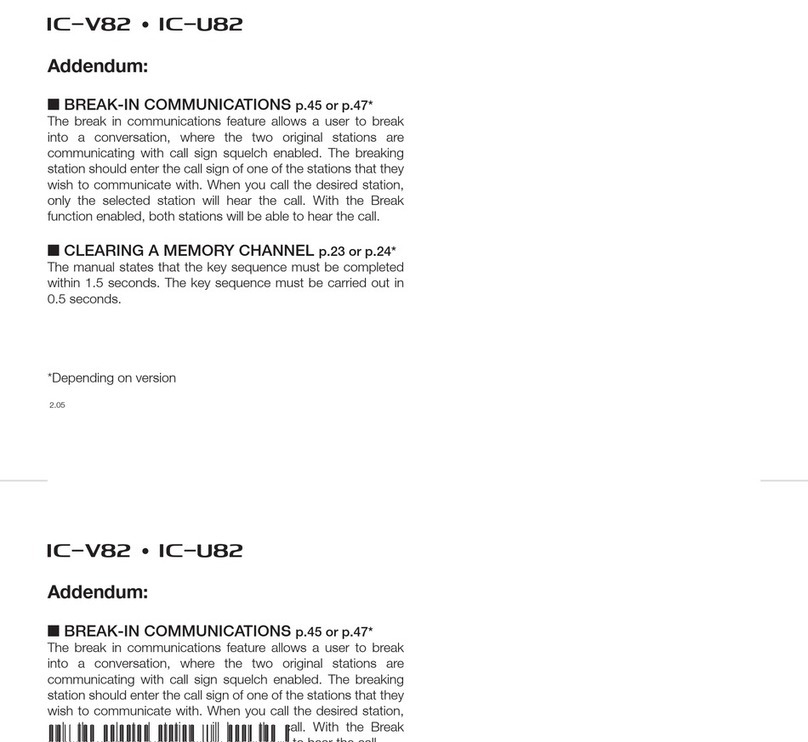
Icom
Icom IC-U82 Installation and operating instructions
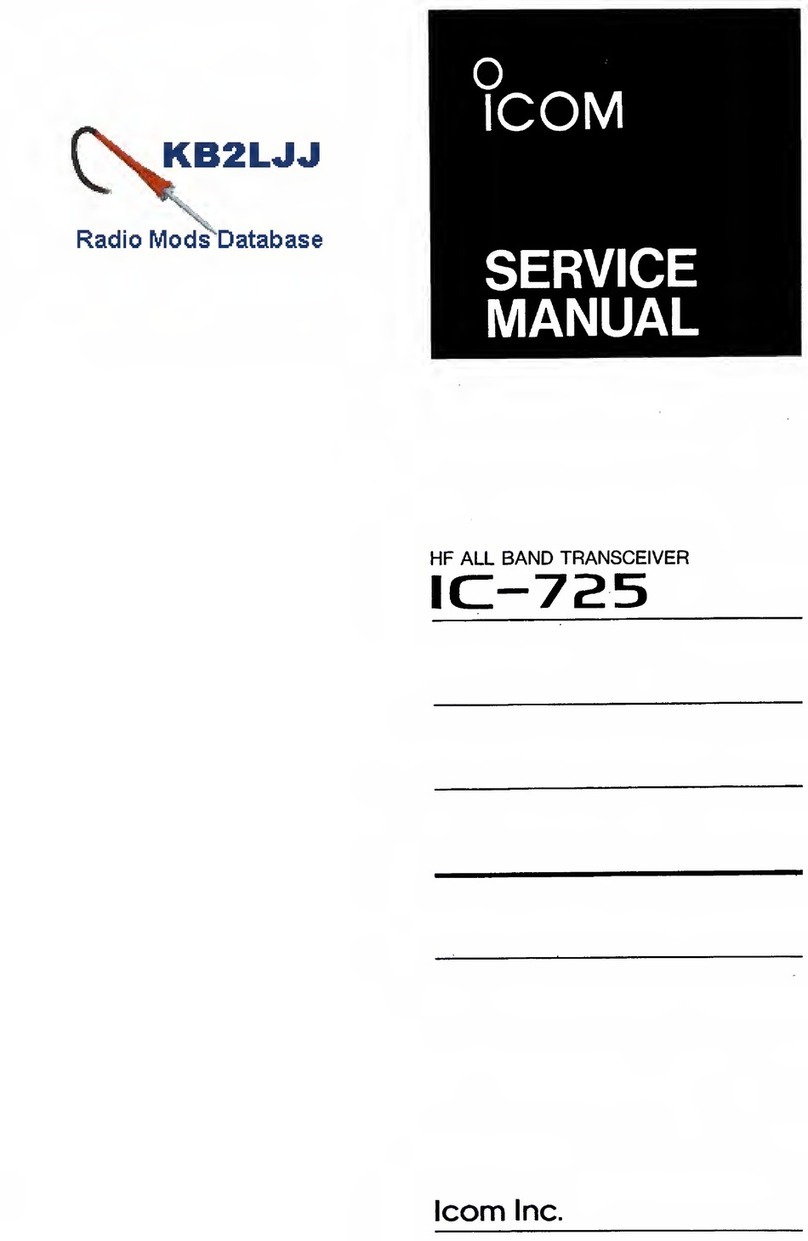
Icom
Icom IC-725 User manual
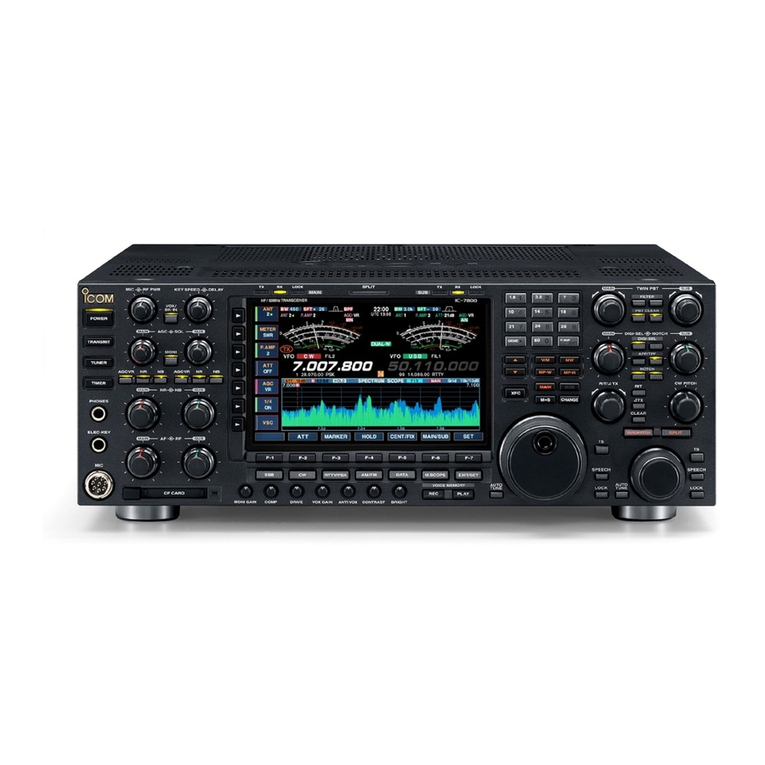
Icom
Icom IC-7800 User manual
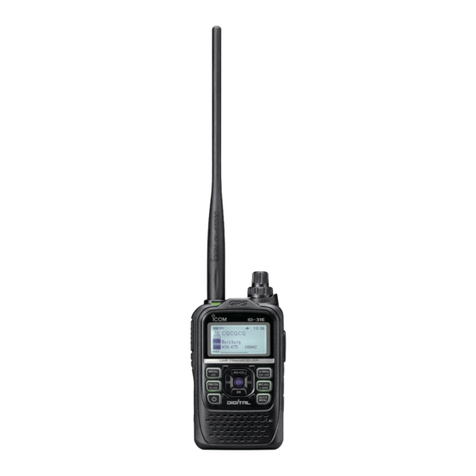
Icom
Icom D-STAR ID-31A; D-STAR ID-31E Setup guide

Icom
Icom IC-2200H User manual
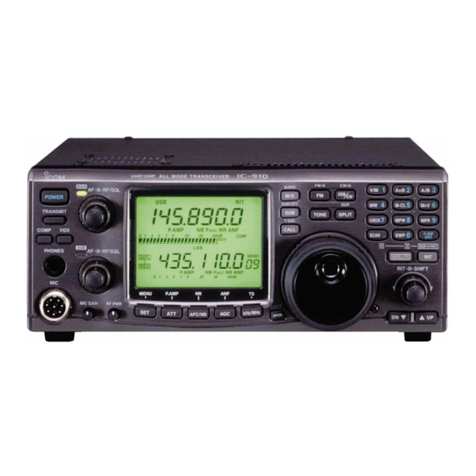
Icom
Icom IC-910H User manual
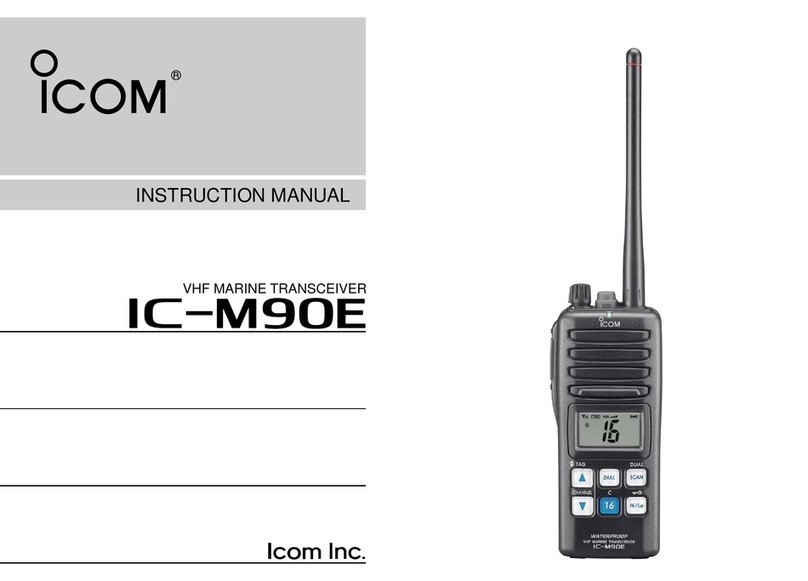
Icom
Icom IC-M90E User manual
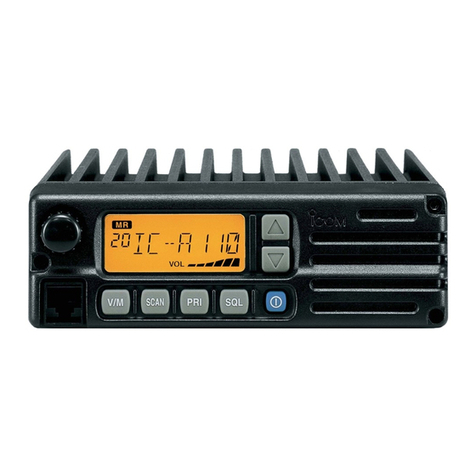
Icom
Icom IC-A110 User manual
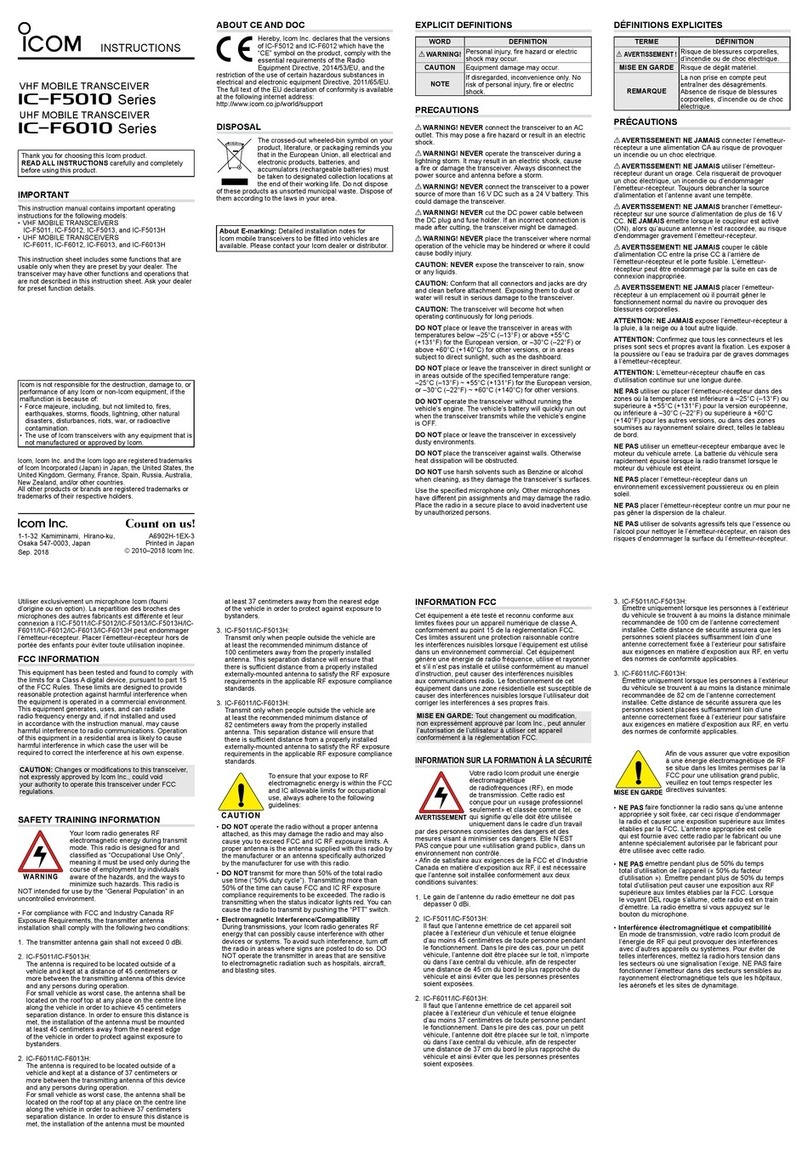
Icom
Icom IC-F5011 User manual

Icom
Icom IC-A110 User manual
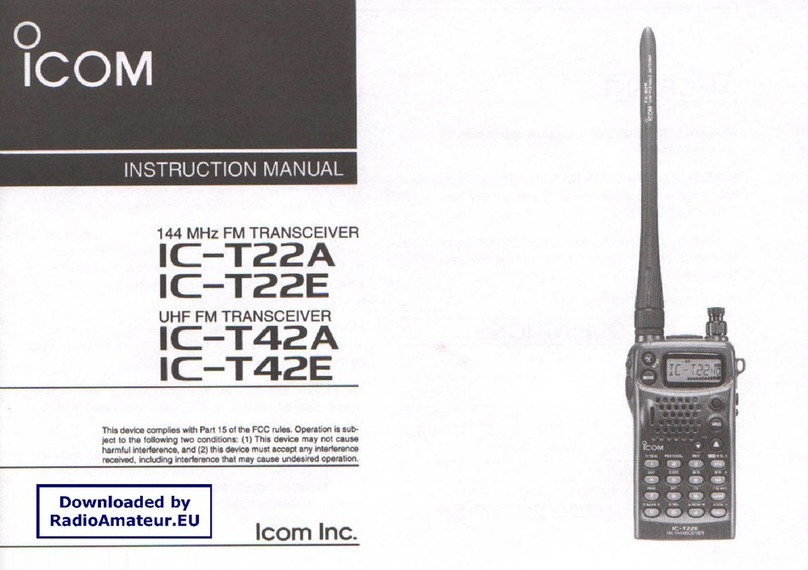
Icom
Icom IC-T22A User manual
